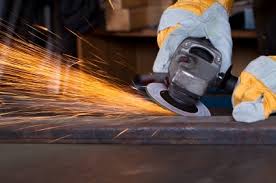Portable abrasive cut off and grinding equipment has been a primary tool for multiple trades in industries for many years, but despite this the legal requirements for their use are still widely misunderstood. When used poorly for the wrong application they can be lethal or at best cause life changing injuries.
An abrasive wheel is a wheel, cylinder, disc or cone made of abrasive particles that have been bonded together using organic or inorganic substances. Abrasive wheels serve an ever wider range of purposes within industry, from grinding and dressing to cutting, and on a wide range of materials.
Abrasive wheels should be fit for purpose. They should only be operated with the correct type of tool and should not exceed maximum operating speed: doubling the speed increases wheel stress by four times, which increases the risk of the wheel bursting.
All tools that drive abrasive wheels need to be regularly examined.
Wheels to BS EN 12413 and BS ISO 525 will be marked to indicate specific restrictions for use, which are:
- RE1 Not permitted for hand-held machines and manually guided grinding
- RE2 Not permitted for hand-held cutting off machines
- RE3 Not permitted for wet grinding. Abrasive product only suitable for dry grinding
- RE4 Only permitted for totally enclosed working area
- RE6 Not permitted for face grinding.
Risk assessments should consider variables such as those given below to ensure adequate protection for operators.
Wheel breakage
Poor storage or wheel selection, improper mounting, extreme out-of-balance conditions or speed, grinding machine defects, or misuse in the grinding operations are all factors that can result in breakage.
Operators must have adequate training and be competent in handling and mounting the wheel and correct speed selection as one of the main causes of wheel breakage is improper mounting or excessive rotational speed of the wheel. It is also important to note that if a wheel breaks, it is likely to shatter, throwing out pieces at high velocity in all directions.
Grinding alloys or metals such as aluminium can “clog” the wheel, causing localised heating and stress in the wheel, frequently resulting in wheel shattering.
Instances of wheel breakage should be carefully investigated to establish the cause and to enable suitable actions to prevent recurrence.
Ejected material
Adequately strong guards should cover as much of the wheel as practicable as many ejected particles are likely to have sharp edges, be dangerously hot, and have a high energy of ejection.
The extent to which the guard covers the wheel is likely to be greater with a fixed wheel rather than one that is used as a portable hand tool, such as a petrol disc cutter or an angle grinder.
Guards can be fixed in position or can be adjustable, and should ensure that the wheel is enclosed to the greatest extent possible, keeping the opening size minimised, by compensating for wheel wear. In addition, it is typically necessary for users to wear eye protection as determined by a risk assessment.
While eye protection complying to a relevant British Standard will protect against most of the smaller ejected particles, it may not protect the user against larger ejected pieces broken off from the wheel or the work-piece. In these cases, protection against ejected material can be achieved by a properly constructed and used transparent guard.
Ejected materials can take many forms, including:
- ground-off fragments of the work-piece
- sparks — the heat generated from the friction of the wheel on the work-piece is likely to be sufficient to ignite even ferrous metals
- small particles from the wheel that are broken off during the abrasive action on the work-piece.
Supervisors must enforce the use of the guards at all times and frequent maintenance of the guards should be carried out.
Contact with the wheel
For the wheel to be used, there has to be an area of it exposed to enable contact with the work-piece. However, it is important that this unprotected area of the wheel is kept at the smallest amount practicable.
The following hierarchy of control measures in the Provision and Use of Work Equipment Regulations 1998 (PUWER) should be applied:
- fixed guarding
- moveable guarding, such as interlocked
- means to keep the operative away from the danger, such as by the use of jigs or holders
- procedural means of risk control, including adequate instruction, information and training.
The measures are to be taken in order “to the extent that it is practicable to do so” before considering the next adequate measure.
The guarding used to protect the operator from ejected particles will control some of the risk of contact with the wheel, but not all.
In the context of the use of an abrasive wheel, the written copy of the risk assessment should show that each of these means of risk control has been considered.
Clamping the work
Work which is mechanically secured is best practice to minimise accidents. Anything which requires a person to hold it manually, such as holding bricks with the foot, should be considered as higher risk.
Use of water
Care needs to be exercised if water is used as part of the process to prevent slippery floors.
Noise
The level at which employers must provide hearing protection and hearing protection zones is 85dB (daily or weekly average exposure) and the level at which employers must assess the risk to workers’ health and provide them with information and training is 80dB. There is also an exposure limit value of 87dB, taking account of any reduction in exposure provided by hearing protection, above which workers must not be exposed. Normally, site signage will indicate the hearing protection zones. Normally, site signage will indicate the hearing protection zones.
In practice, noise levels must be assessed and action taken in line with the Control of Noise at Work Regulations 2005. Where noise levels exceed the action levels stipulated in the regulations then appropriate action must be taken. This may include the use of quieter tools and processes, the use of hearing protection and health surveillance by audiometry.
Vibration
Employers must assess their employees’ exposure to vibration and take steps as necessary to reduce exposure. The HSE’s vibration calculator (See the News Article on HAV – Exposure Calculator) can be used to calculate how long it is permissible to run each type of abrasive wheel.
Steps for reducing exposure to vibration include changing the equipment, reducing the exposure time, and changing work methods. Health surveillance may be necessary.
Anti-vibration mountings must be replaced at suitable periods not exceeding the manufacturer’s recommended intervals in order to prevent ill health from exposure to vibration.
Dusts
There is a clear requirement under the Control of Substances Hazardous to Health Regulations 2002 for employers and the self-employed to assess and control the risks from dust exposure and various workplace exposure limits exist. Often, natural ventilation is all that will be available to control exposure to dusts. If wet cutting is not possible, e.g. inside a building, then on-tool extraction will be essential. There can be particular risks with concrete and masonry dusts, and consideration should be given to the possible need for respiratory protective equipment (RPE), or the use of local exhaust ventilation (LEV). RPE should be used as a last resort.
The precise selection of the type of LEV and its installation and use is very dependent on the abrasive wheel and the type of work being undertaken.
Fire
The choice of tool on which to mount an abrasive wheel should only be made after consideration of the environmental conditions of operation, e.g. flammability, solvents in the vicinity, conductivity. Fire risk assessments consider potential ignition sources, which would include sparks from ejected particles of steel, etc and hot engine exhausts. This is related to the number of people at risk and the fuels that might be available for a fire, e.g. packing material. The risk is reduced by introducing control methods such as emergency procedures, fire-fighting equipment, the provision of protected escape routes and management procedures such as a hot work permit.
Electrical
Electrical risks to be considered arise from cutting power supplies or damage to machines which drive abrasive wheels.
Electrical tools must have portable appliance tests (PATs) which identify electrical safety faults. Air-powered tools will need hose checks and governor speed checks. Petrol-driven tools must have engine maintenance, filter changes, etc. Engineers should use these services to double check that guards are secure, the tool is operating safely and on/off switches are reliable.
Manual Handling
Manual handling risks mainly involve the handling of products before or after cutting or grinding, but may also include carrying heavy equipment to the work site.
Site Rules for the Use of Grinding Equipment
Rules and procedures should apply to the use of any grinding equipment owned or hired by the company and to work undertaken by employees, whether temporary, permanent or contractors. It should also apply to all operators, maintenance workers and other staff in order to minimise risk to themselves and all other persons working on, or visiting, the site.
User Inspection of Both Tool and Task Should be Required.
Only authorised and trained persons should operate abrasive wheels.
The written, safe system of work should be incorporated into training programmes for operators and maintenance workers, with relevant parts incorporated into induction training for other staff, and instructions to contractors or other persons visiting the site, e.g. emergency procedures and first-aid arrangements.
Abrasive Wheel Selection
Wheels should be of the correct diameter and speed rating for the machine, and of the correct material and hardness for the tasks to be performed.
Selecting the appropriate wheel for the job is equally important for efficient production and for safety.
Information on the wheel size, angular velocity (rpm) and reference number should be marked on the central portion of the flat sides of the wheel. This information should be compatible with the machine motor characteristics. This underlines the importance of discussing the wheel selection with the supplier, giving them the details of the task and the motor and mounting.
As a rough guide, soft wheels are preferred on hard material and hard wheels on soft material.
Abrasive Wheel Fitting (Training in the Safe Selection and Mounting of an Abrasive Wheel)
Only competent persons who have successfully completed a training schedule that covers the requirements of Regulation 9 of PUWER (and includes the inspection, testing, fitting and dressing of wheels) may carry out the fitting of new wheels. Abrasive wheels are relatively fragile and should not be subjected to rough handling. Damage can occur if the manufacturer’s spanners are not used for mounting the wheel (i.e. securing it to the tool).
Wheels should fit freely, but not loosely, on the spindle. If the wheel grips the spindle or flange location diameter, heat generated during the grinding operation could cause the spindle to expand and the wheel may crack.
Inspection
It is necessary to carry out routine checks, regular inspection and preventive maintenance that includes daily/weekly service checks, formal visual inspections and combined inspection and tests before first-time use and then every month.
Any tool found to be in a non-serviceable or unsafe condition must be withdrawn from use, until defects have been rectified by a person competent to carry out this class of work.
Competent Operation – (Training in the Safe Use)
Employers are required to ensure that those who use abrasive wheels are competent to do so. This will include the provision of suitable training and supervision. Training courses are offered by many organisations which usually provide a certificate of attendance, not competence.
The certificate issued should refer to the class of machine in which the individual was trained.
This training is easily over-sighted, employers assume the safe selection and mounting of the wheel is evidence of sufficient training for the equipment’s use. When accidents occur using this equipment, it is often established that the equipment was not being used in the way in which it should have been with an unsuitable blade/wheel fitted. However, don’t be surprised that even when the correct blade/wheel is fitted, failure can still occur due to poor operation.











